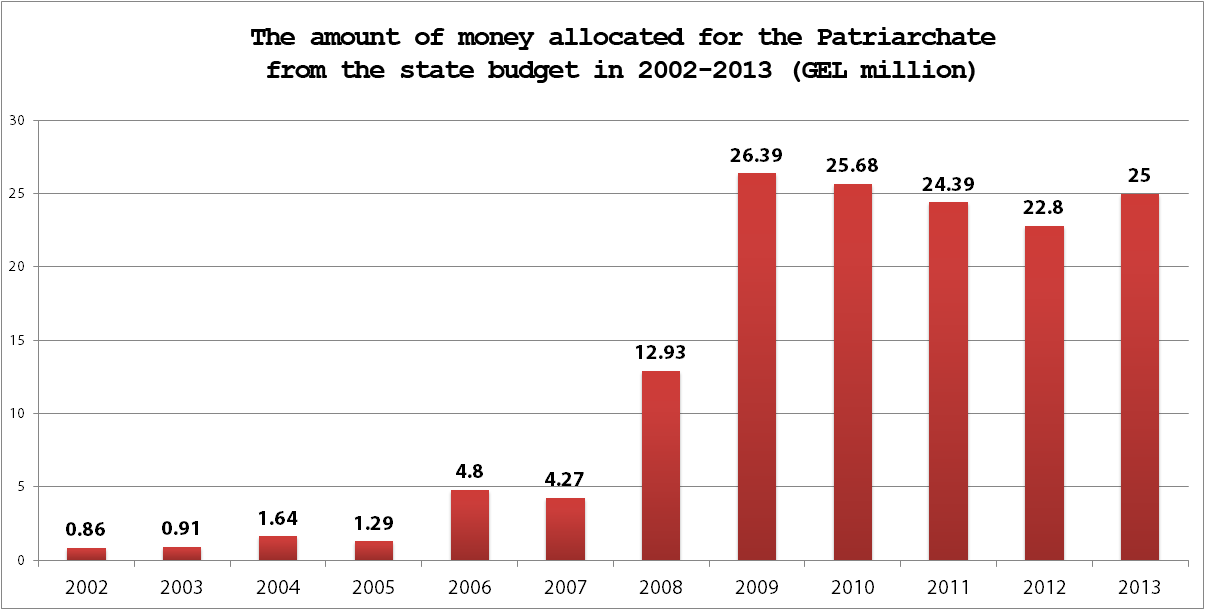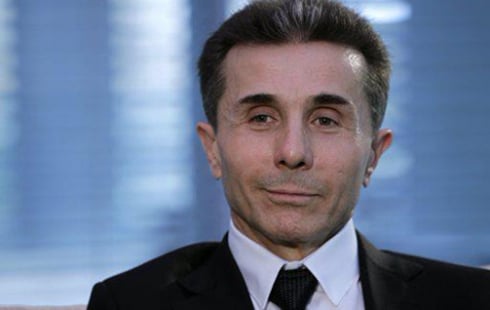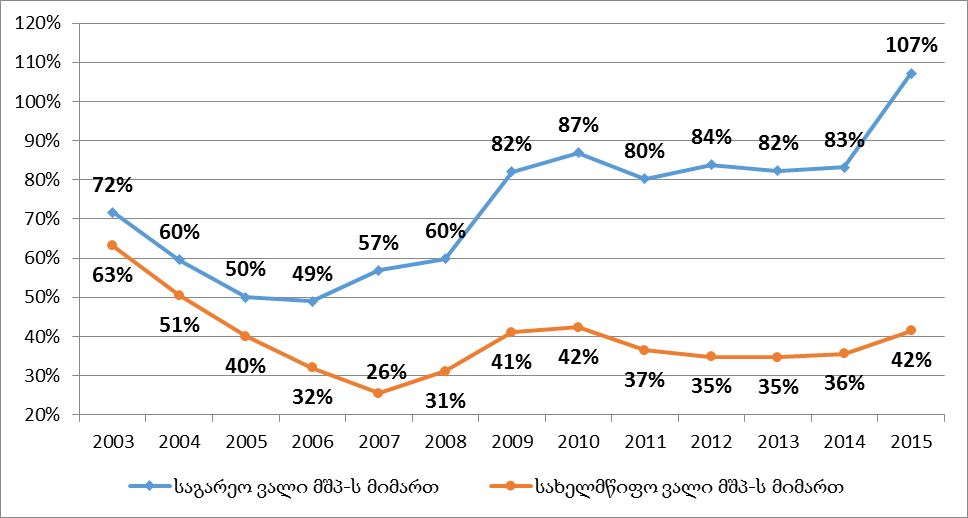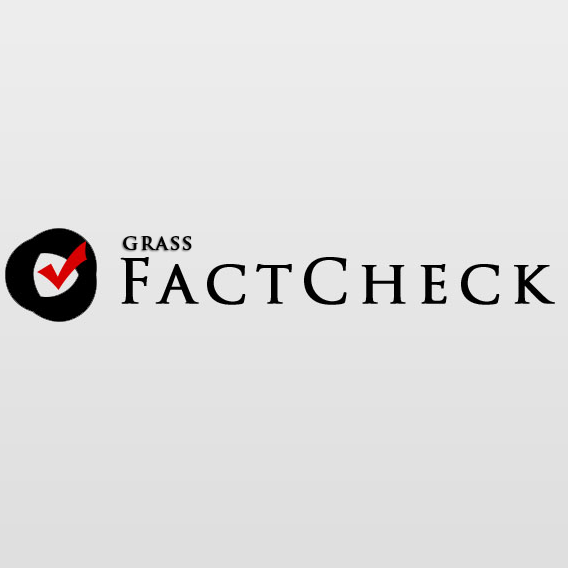On 30 May 2016, the former Prime Minister of Georgia and founder of the Georgian Dream party, Bidzina Ivanishvili, addressed the population with a letter which gives a comparison of the situation under the rule of the previous and incumbent governments. Mr Ivanishvili believes that the new Government of Georgia has improved the situation in absolutely every aspect listed in his letter.
FactCheckverified the accuracy of several of Bidzina Ivanishvili’s statements in the letter. Other verified facts will be added to these statements throughout this week.
As illustrated by Table 1 below, the number of employees in the private sector over the last three years increased by 54,660 persons. The growth in the number of employees in the private sector reached 63,394 between 2006-2012. The total number of employed persons decreased by 23,000 between 2006-2012 and includes both private and public sectors. The decrease in the total number of employed persons was caused by a drop in the number of persons employed in the public sector and so portraying this number as a private sector employment indicator misleads the reader.
In his letter, Bidzina Ivanishvili uses the method of comparing the total indicators (for instance, in the cases of investments, construction and tourism) for 2013-2015 to the total indicators for 2010-2012. However, he does not use this method when it comes to employment (this method is the best one for analysing employment indicators) and compares the 2013-2015 data to those of the previous six years (although he does it incorrectly). If we compare the growth of employment in the private sector in 2010-2012 and 2013-2015, we will see that 92,600 jobs were created in 2010-2012 whilst this number was 54,600 (38,000 less) in 2013-2015. The average pace of employment growth in the non-state sector was 2.25% in 2010-2012 and 1.24% in 2013-2015.
This means that more jobs were created in a faster manner in 2010-2012 than in 2013-2015. However, the letter is an attempt to prove the opposite.
Table 1:
Employment in Terms of Institutional Sectors (thousand men)
| 2006 | 2007 | 2008 | 2009 | 2010 | 2011 | 2012 | 2013 | 2014 | 2015 | |
| Total | 1,747 | 1,704 | 1,602 | 1,656 | 1,628 | 1,664 | 1,724 | 1,712 | 1,745 | 1,780 |
| State Sector | 360 | 327 | 275 | 298 | 286 | 266 | 274 | 247 | 251 | 275 |
| Non-state Sector | 1,387 | 1,377 | 1,327 | 1,358 | 1,342 | 1,398 | 1,450 | 1,465 | 1,494 | 1,505 |
The comparison of data from the period of the world economic crisis (2009-2010) to the data of the last years is irrelevant. In the years 2009-2010, foreign investments decreased worldwide because the majority of countries were in an economic crisis. In regard to the prognosis for 2016, this is unknown to FactCheck
and, therefore, we can only analyse the 2013-2015 data. In this period, a total of USD 4,050 million in FDI was made in Georgia which is 43% more than the FDI of the previous three years (2010-2012) taken together. Of note is that before the start of the world financial crisis, in the three preceding years (2006-2008), USD 718 million more in FDI was invested than in the years 2013-2015.
| Year | 2006 | 2007 | 2008 | 2009 | 2010 | 2011 | 2012 | 2013 | 2014 | 2015 |
| FDI (USD million) | 1,190 | 2,015 | 1,564 | 658 | 815 | 1,117 | 912 | 942 | 1,758 | 1,351 |
However, comparing the combined data of several years is futile for the purpose of estimating economic trends. This approach can only succeed in manipulating the numbers and misleading the population. In order to check whether or not the investment growth trend is positive, we have to see the number for the annual percentage growth. Investments grew by 3% in 2013 and by 87% in 2014 with the FDI decreasing by 23% in 2015 as compared to 2014. An FDI growth trend is visible but it is more important for the development of the country to have growth registered in the last year (2015) and not the fact that the volume of investments in the last year exceeds the same number registered three years ago. When a country’s economy grows (even as slowly as in 2012-2015), it is necessary to attract more and more investments in order to keep a positive pace of economic development. Therefore, it is much more important for the population to be aware of exact information in terms of investment trends in the last years rather than being informed about the fact that investments are so much larger today as compared to some date in history.
According to the data of the National Statistics Office of Georgia, export to EU countries amounted to USD 352.2 million in 2012 and USD 646.4 million in 2015. Therefore, exports to the EU in 2015 grew by 83% as compared to 2012.
Bidzina Ivanishvili did not elaborate further on the topic of export in his letter. He did not mention the data from 2016 according to which export to EU countries dropped by 28% in January to April as compared to the same period of the previous year. He also did not say anything about Georgia’s total exports which have been on the continuous decline since 2013. Exports decreased by 1.7% in 2014, by 23% in 2015 and by 12% in January-April 2016.
Several international organisations, such as Freedom House, Reporters without Borders and IREX, among others, are conducting research in terms of media freedom in different countries.
According to Freedom House’s 2016 report, the situation in Georgia in terms of media freedom improved by 0.25 points in 2014. Since 2014, the situation has not changed and the number remains unaltered.
According to the Reporters without Borders 2016 report, Georgia’s media freedom index worsened by 0.26 points as compared to the previous year. However, the country moved upward in terms of its ranking from the 69th to the 64thplace. This happened because the media freedom index of other countries dropped even more than Georgia’s.
According to IREX’s research, Georgia’s media sustainability index has been worsening somewhat since 2014. However, the country still remains within the category of countries with sustainable media.
Of note is that each and every report of the aforementioned international organisations speaks about the problems in Georgia’s media environment and signs of political oppression (facts of closure of talk shows both at Imedi TV and the Public Broadcaster alongside the Rustavi 2 court trial as examples). Freedom House’s 2016 report says: "The investigation and prosecution of the leading opposition media outlet, Rustavi 2, points to political pressure by elements of the ruling coalition" (see link 1, link 2 – page 2, link 3– page 169).
Of separate mention are the developments in regard to Maestro TV which resulted in management changes. On 3 June 2016 several broadcasts were shut down and 32 employees had their labour contracts terminated.
FactCheck has previously written about the topic of inmates and probationers
under the rule of the United National Movement (2004-2012).
According to the information of the Ministry of Corrections and Legal Assistance of Georgia, the situation in regard to the number of prisoners in Georgia was the following in 2004-2012:
In regard to the number of probationers, Georgia’s legislation does not have an official legal definition of the term probationer. According to the information of the National Probation Agency the term probationer includes individuals who were convicted on a conditional basis and were later conditionally released before serving their term.
The number of conditionally convicted and early released individuals in 2004-2012 was the following:
| Years | Conditionally Convicted Individuals | Conditionally Released |
| 2004 | 6,277 | 1,197 |
| 2005 | 7,827 | 1,212 |
| 2006 | 9,558 | 558 |
| 2007 | 16,073 | 245 |
| 2008 | 21,387 | 499 |
| 2009 | 26,628 | 409 |
| 2010 | 31,986 | 186 |
| 2011 | 38,681 | 136 |
| 2012 | 33,109 | 604 |
| Total | 191,526 | 5,046 |
Of note is that these statistics do not allow us to calculate the number of prisoners and probationers in 2004-2012 because one and the same individual could be registered in several years. Thus, simply adding up the figures cannot give us a real picture. However, a rough calculation demonstrates that the number of prisoners and probationers fluctuates between 100,000 and 200,000.
According to the annual statistics of the Council of Europe, there were 865.73 probationers per 100,000 citizens in 2011. With this number, Georgia was in the first place among Council of Europe member states. In 2013-2014, the number of probationers decreased drastically which was duly reflected upon an international level with Georgia moving from the first place to the 13th.Even though the number of prisoners or probationers was not in the "hundreds of thousands," the aforementioned numbers are high enough. Multiple local and international organisations have talked about the high numbers of prisoners and probationers.
It is false to argue that under the previous government, only well-off citizens could afford healthcare. As of 2012, citizens for whom healthcare services were least affordable used to have a state health insurance. These citizens included: the population below the poverty line, IDPs living in compact settlements, children without care, children to the age of five years, pensioners, students, disabled children and children with visible disabilities. See FactCheck’s article. The second part of the former Prime Minister’s statement is not fully precise either. The Universal Healthcare Programme was launched by the state in 2013 and began covering all citizens who did not have any other health insurance. Naturally, the aforementioned programme increased the accessibility to healthcare. However, the Universal Healthcare Programme does not envisage funding or co-funding to purchase medication even though more than half of total healthcare expenditures is spent on medication (see FactCheck’s article 1 and article 2).
In order to check the statistical data, we contacted the Ministry of Labour, Health and Social Affairs of Georgia where they explained that they keep statistics according to the number of individual cases; however, they also have data on the number of persons who have used hospital services.
A total of 1,319,650 persons have used hospitals in terms of the Universal Healthcare Programme from 2013 to date. Beneficiaries who used only outpatient services must also be added to this number. As for the amount of individual cases, a total of 2,547,032 cases were recorded in terms of the Universal Healthcare Programme.
The Ministry of Labour, Health and Social Affairs of Georgia started implementing the Hepatitis C Elimination programme in April 2015 and it has been ongoing non-stop ever since. The programme includes a free-of-charge screening (identification of the disease) as well as free-of-charge treatment with cutting-edge, expensive medications (see FactCheck’s article
about this issue).
The programme is being implemented with the support of an American pharmaceutical company, Gilead, which supplies Georgia with the medications necessary for the treatment of hepatitis C (Sofosbuvir, Harvon) also free-of-charge. The Ministry of Labour, Health and Social Affairs of Georgia provides all of the necessary secondary medications.
According to the most recent data from the Ministry, a total of 10,000 patients are currently participating in the programme whilst about 6,000 have already finalised the treatment procedures with over 90% completely cured of the disease.
If hepatitis C is completely eliminated in Georgia, it will become the very first country in the world to have achieved such a result and indeed represent an achievement which is unprecedented in the field of global healthcare.
The overall length of irrigation channels in Georgia is 39,918 km. According to the information of the United Amelioration Systems Company of Georgia, practically all of the major and distributive irrigation channels in Georgia have been rehabilitated. The land area provided with irrigation water has increased 2.3 times since 2012, reaching 104,000 hectares.
Chart 1:
Land Area Provided with Irrigation Water (Hectares) from 2012 to 2016
As the chart reflects, a total of 45,000 hectares of land was supplied with irrigation water in 2012 whilst this area has increased to 104,000 hectares so far in 2016. Hence, the land area provided with irrigation water has increased by 130% in 2016 as compared to 2012.
Two programmes which provide interest-free loans from state institutions are being implemented in the field of agriculture; namely, the Preferential Agro Credit and Product of Georgia programmes. The Preferential Agro Credit programme consists of seven components, only one of which is interest-free (0%) – a goods credit for small farms. The amount of the loan is up to GEL 5,000 and the length of the loan is six months (see FactCheck’s Article 1, Article 2, Article 3 and Article 4
about this issue).
All of the programme’s remaining components only provide co-financing and are not interest-free. The amount of interest for the farmers varies from 3% to 8%.
As for the Product of Georgia programme, the state covers 10% of the loan in the first two years with only 1%-2% paid by the beneficiary. There is also a programme component for the funding of processing and storage facilities. State co-funding for these activities varies from 40% to 50% whilst the finances provided by the beneficiary must not be below 10% of the individual activity’s overall value.
Despite the fact that one of the components (funding small farms) of the Preferential Agro Credit programme is interest-free, it cannot be regarded as a long-term loan as its term for completion is six months. It is also not easy to say whether or not these loans are available to all citizens. In order to participate in the programme, the beneficiary must meet the requirements of participating financial institutions which, in the cases of banks, include ensuring the loan with a property guarantee which is definitely not possible for every citizen.
Bidzina Ivanishvili has not stated any facts confirming this statement in his letter. Hence, the basis of this statement is unknown to us. We have looked at several statistical figures in order to verify the accuracy of the statement.
The constitutional agreement between the state and the Georgian Orthodox Church was signed in 2002 after which the Patriarchate is being funded from the state budget. The money allocated for this purpose reached record high levels during the office of the United National Movement. The amount of money allocated by the Ministry of Finance of Georgia for the Patriarchate amounted to a total of GEL 125.1 million from 2003 to 2012. Apart from the state budget, the Church was also being funded from government funds and municipality budgets. For example, from 2006 to 2012 Mikheil Saakashvili allocated a total of GEL 10.4 million for the Patriarchate from the Presidential Fund. Apart from the funding, we also have numerous cases of free-of-charge property transfers from the state to the Church. A perfect illustration of this is the Ministry of Internal Affairs of Georgia giving EUR 110,000 worth of cars to the Patriarchate in 2010.

Various civil society representatives criticised the previous government for their policy towards the Patriarchate; however, the reasons stated by these critics differ greatly from those stated by Mr Ivanishvili. They believed that the United National Movement’s government closely cooperated with the Church and this was weakening the secular foundations of the state. They also believed that allocating money from the state budget to the Orthodox Church only amounted to discrimination towards other religious groups in Georgia.
The World Governance Indicators were last updated on 25 September 2015 and included the data from 1996 to 2014. According to the data from 2014, Georgia’s ratings improved in all six indicators and did reach their maximum in 18 years.
Chart 1:
World Governance Indicators (Percentile Ratings)
 Source: World Bank
Source: World Bank
We had positive trends in absolute numbers as well (see Chart 2). Five indicators improved as compared to the previous period and also reached their all-time maximum ratings: freedom of expression and accountability, political stability and the eradication of violence/terrorism, regulation level, rule of law and corruption control. The only exception is the government effectiveness indicator which reached its maximum of 0.57 in 2012. It dropped to 0.53 in 2013 and decreased even further to 0.48 in 2014. Despite the trend of a decrease in absolute numbers, the government effectiveness indicator increased as compared to other countries, reaching 71.63 in 2014 as its all-time maximum (see Chart 1).
Chart 2:
World Governance Indicators (Absolute Numbers)
 Source: World Bank
Source: World Bank
The situation for 2015 and 2016 according to these indicators is yet unknown. It will be made available in new World Bank reports.










